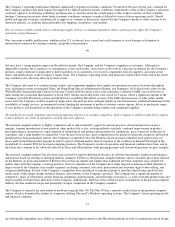Apple 2003 Annual Report Download - page 24
Download and view the complete annual report
Please find page 24 of the 2003 Apple annual report below. You can navigate through the pages in the report by either clicking on the pages listed below, or by using the keyword search tool below to find specific information within the annual report.
• Second, overall unit sales of Macintosh portable systems grew by 92,000 units or 10% in 2002 reflecting a general trend in the
personal computer market away from desktop systems towards portable systems. During 2002, portable Macintosh systems
represented 33% of total systems sales versus 31% in 2001 and 20% in 2000. Growth in this area has been most pronounced for
iBook, the Company's education and consumer oriented portable Macintosh system. iBook unit sales increased 14% in 2002 and
9% in 2001.
• Third, the Company's Retail segment grew from 8 stores at the end of 2001 to 40 stores at the end of 2002. The Retail segment's
net sales grew from $19 million in 2001 to $283 million in 2002. While the Retail segment may have cannibalized some net
sales from the Company's preexisting sales channels in the U.S., the Company believed that a substantial portion of the Retail
segment's net sales was incremental to the Company's total net sales. See additional comments below related to the Retail
segment under the heading "Segment Operating Performance."
27
•
Fourth, the Company's average unit pricing increased 3% during 2002 as a result of various changes in overall unit mix offset by
somewhat lower pricing year-over-year on comparative Macintosh systems. Net sales per Macintosh unit sold during 2002 of
$1,462 per unit reflected the shift in mix towards relatively higher-priced portable Macintosh systems and reflected the impact
on net sales of the relatively higher-priced new iMac design introduced during 2002. The impact of these changes in mix were
offset by the decline in unit sales of relatively higher-priced Power Macintosh systems and by lower pricing on comparative
Macintosh systems during 2002 for most of the Company's Macintosh product lines in response to industry pricing pressure.
• Fifth, any comparison of net sales in 2002 versus 2001 must consider the effect of unusually low net sales during the first
quarter of 2001. This was attributable to several factors at the beginning of 2001, including continued deterioration in worldwide
demand for personal computers, rebate programs and price cuts instituted by the Company during that quarter that cost the
Company approximately $138 million, and a plan implemented by the Company during the first quarter of 2001 that reduced
substantially the level of inventory in its distribution channels that resulted in a decline in channel inventory of approximately
300,000 units during that quarter.
Offsetting the favorable factors discussed above, the Company's net sales in 2002 were negatively impacted by several notable factors.
• First, unit sales of Power Macintosh systems fell 18% during 2002 as compared to 2001. This followed a 35% decline in Power
Macintosh unit sales in 2001 from 2000. The Company believed that weak economic conditions over the past several years had
a pronounced negative impact on its professional and creative customers and that many of these customers continued to delay
upgrades of their Power Macintosh systems due to the Company's ongoing transition to Mac OS X, its new operating system,
and in anticipation of certain software vendors transitioning their Macintosh applications to run natively in Mac OS X. Further,
the Company did not experience the anticipated increase in Power Macintosh sales that it expected following the introduction of
Adobe's PhotoShop 7 during 2002. Additionally, many professional users may have postponed upgrading their systems until
after the introduction of Mac OS X Jaguar released in the fourth quarter of 2002. Others may have delayed upgrading until after
the availability of other professionally oriented software applications for Mac OS X such as QuarkXPress.
• Second, despite the overall increase in net sales during 2002 in the Americas, the Company continued to see weakness in its
U.S. education channel. Total net sales in this channel fell 15% in 2002 and 4% in 2001. These declines were consistent with
industry data that showed the Company losing market share in the U.S. education market in each of the last two fiscal years. The
Company believed this weakness was caused by multiple factors, including increased price competition in this price sensitive
market from the Company's competitors who sell Windows-based personal computers. Additionally, some of the Company's
education customers appeared to be delaying technology purchases due to concerns about the overall impact of the weaker
economy on their available funding.
• Third, the personal computer industry in general and the Company specifically experienced soft demand for its products due to
adverse global economic conditions, political uncertainties, and a lengthening of consumer, creative, and business personal
computer upgrade cycles.
Segment Operating Performance
The Company manages its business primarily on a geographic basis. The Company's reportable operating segments are comprised of the
Americas, Europe, Japan, and Retail. The Americas segment includes both North and South America, except for the activities of the Company's
Retail segment. The Europe segment includes European countries as well as the Middle East and Africa. The Japan segment includes only
Japan, except for the activities of the Company's Retail segment. The Retail segment currently operates
28
























